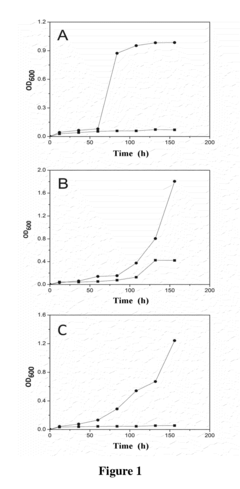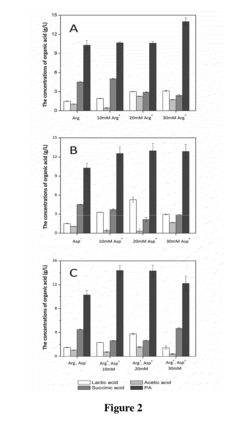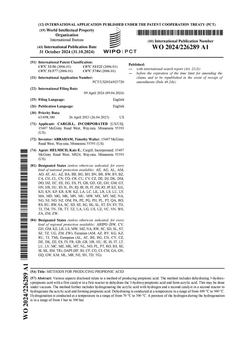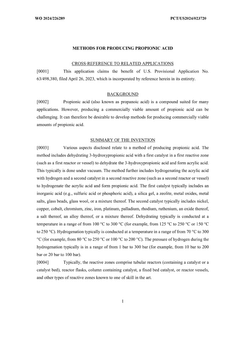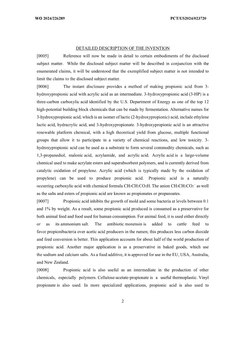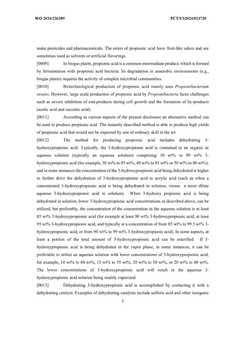How to Accelerate Propionic Acid Adoption in Market Applications?
JUL 3, 20258 MIN READ
Generate Your Research Report Instantly with AI Agent
Patsnap Eureka helps you evaluate technical feasibility & market potential.
Propionic Acid Market Overview and Objectives
Propionic acid, a versatile organic compound, has been gaining significant attention in various market applications due to its unique properties and potential benefits. The global propionic acid market has been experiencing steady growth, driven by increasing demand from diverse industries such as food and beverages, pharmaceuticals, agriculture, and personal care products. As of 2021, the market size was estimated at approximately $1.5 billion, with projections indicating a compound annual growth rate (CAGR) of around 6% over the next five years.
The primary objective of accelerating propionic acid adoption in market applications is to capitalize on its multifaceted advantages and expand its utilization across different sectors. One of the key drivers for this growth is the rising demand for natural food preservatives, as propionic acid and its derivatives are widely used to inhibit mold growth and extend the shelf life of various food products. Additionally, the increasing awareness of the antimicrobial properties of propionic acid has led to its growing adoption in the pharmaceutical and personal care industries.
In the agricultural sector, propionic acid has gained traction as an effective grain preservative, helping to prevent spoilage and reduce post-harvest losses. This application is particularly crucial in developing countries where proper storage facilities may be limited. Furthermore, the compound's potential as a sustainable alternative to traditional chemical preservatives aligns well with the global trend towards eco-friendly and natural solutions.
The market for propionic acid is characterized by a mix of established players and new entrants, with ongoing research and development efforts focused on improving production processes and exploring novel applications. Key market players are investing in capacity expansion and technological advancements to meet the growing demand and maintain their competitive edge. Geographically, North America and Europe currently dominate the market, but Asia-Pacific is emerging as a rapidly growing region due to increasing industrialization and changing consumer preferences.
To accelerate propionic acid adoption, several objectives need to be addressed. These include enhancing production efficiency to reduce costs, developing new formulations and applications to expand market reach, and increasing awareness of the compound's benefits among potential end-users. Additionally, regulatory compliance and sustainability considerations play crucial roles in shaping the market landscape and influencing adoption rates across different regions and industries.
The primary objective of accelerating propionic acid adoption in market applications is to capitalize on its multifaceted advantages and expand its utilization across different sectors. One of the key drivers for this growth is the rising demand for natural food preservatives, as propionic acid and its derivatives are widely used to inhibit mold growth and extend the shelf life of various food products. Additionally, the increasing awareness of the antimicrobial properties of propionic acid has led to its growing adoption in the pharmaceutical and personal care industries.
In the agricultural sector, propionic acid has gained traction as an effective grain preservative, helping to prevent spoilage and reduce post-harvest losses. This application is particularly crucial in developing countries where proper storage facilities may be limited. Furthermore, the compound's potential as a sustainable alternative to traditional chemical preservatives aligns well with the global trend towards eco-friendly and natural solutions.
The market for propionic acid is characterized by a mix of established players and new entrants, with ongoing research and development efforts focused on improving production processes and exploring novel applications. Key market players are investing in capacity expansion and technological advancements to meet the growing demand and maintain their competitive edge. Geographically, North America and Europe currently dominate the market, but Asia-Pacific is emerging as a rapidly growing region due to increasing industrialization and changing consumer preferences.
To accelerate propionic acid adoption, several objectives need to be addressed. These include enhancing production efficiency to reduce costs, developing new formulations and applications to expand market reach, and increasing awareness of the compound's benefits among potential end-users. Additionally, regulatory compliance and sustainability considerations play crucial roles in shaping the market landscape and influencing adoption rates across different regions and industries.
Market Demand Analysis for Propionic Acid
The global market for propionic acid has been experiencing steady growth, driven by its versatile applications across various industries. The demand for propionic acid is primarily fueled by its use as a food preservative, particularly in the bakery industry, where it effectively inhibits mold growth and extends shelf life. This application alone accounts for a significant portion of the market share, with the food and beverage sector being the largest consumer of propionic acid.
In the animal feed industry, propionic acid has gained traction as an effective feed preservative and mold inhibitor. As the livestock industry continues to expand globally, the demand for propionic acid in this sector is expected to witness substantial growth. The increasing focus on animal health and nutrition further bolsters this trend.
The pharmaceutical industry represents another key market for propionic acid, where it is used as an intermediate in the production of various drugs and active pharmaceutical ingredients. The growing pharmaceutical sector, particularly in emerging economies, is likely to contribute to the increased adoption of propionic acid in coming years.
In the agrochemical sector, propionic acid finds applications in the production of herbicides and plant growth regulators. As agricultural practices evolve and the need for crop protection intensifies, this segment is anticipated to offer significant growth opportunities for propionic acid manufacturers.
The cosmetics and personal care industry also utilizes propionic acid in the formulation of various products, including skin care and hair care items. The rising consumer awareness regarding personal grooming and the expanding beauty industry are expected to drive demand in this sector.
Geographically, North America and Europe currently dominate the propionic acid market, owing to the presence of established food and pharmaceutical industries. However, the Asia-Pacific region is emerging as a lucrative market, with rapid industrialization and increasing disposable incomes driving demand across various end-use industries.
Market analysts project a compound annual growth rate (CAGR) for the global propionic acid market in the coming years. This growth is attributed to the expanding applications of propionic acid, particularly in developing economies, and the increasing demand for natural food preservatives. However, factors such as volatility in raw material prices and stringent regulations regarding chemical usage in food products may pose challenges to market growth.
In the animal feed industry, propionic acid has gained traction as an effective feed preservative and mold inhibitor. As the livestock industry continues to expand globally, the demand for propionic acid in this sector is expected to witness substantial growth. The increasing focus on animal health and nutrition further bolsters this trend.
The pharmaceutical industry represents another key market for propionic acid, where it is used as an intermediate in the production of various drugs and active pharmaceutical ingredients. The growing pharmaceutical sector, particularly in emerging economies, is likely to contribute to the increased adoption of propionic acid in coming years.
In the agrochemical sector, propionic acid finds applications in the production of herbicides and plant growth regulators. As agricultural practices evolve and the need for crop protection intensifies, this segment is anticipated to offer significant growth opportunities for propionic acid manufacturers.
The cosmetics and personal care industry also utilizes propionic acid in the formulation of various products, including skin care and hair care items. The rising consumer awareness regarding personal grooming and the expanding beauty industry are expected to drive demand in this sector.
Geographically, North America and Europe currently dominate the propionic acid market, owing to the presence of established food and pharmaceutical industries. However, the Asia-Pacific region is emerging as a lucrative market, with rapid industrialization and increasing disposable incomes driving demand across various end-use industries.
Market analysts project a compound annual growth rate (CAGR) for the global propionic acid market in the coming years. This growth is attributed to the expanding applications of propionic acid, particularly in developing economies, and the increasing demand for natural food preservatives. However, factors such as volatility in raw material prices and stringent regulations regarding chemical usage in food products may pose challenges to market growth.
Current Challenges in Propionic Acid Adoption
Despite the numerous advantages and potential applications of propionic acid, its widespread adoption in various market sectors faces several significant challenges. One of the primary obstacles is the relatively high production cost compared to alternative substances. The current manufacturing processes, predominantly petrochemical-based, are energy-intensive and often rely on expensive catalysts, resulting in a higher price point that can deter potential users from incorporating propionic acid into their products or processes.
Another challenge lies in the limited production capacity and supply chain constraints. The global production of propionic acid is concentrated among a few major manufacturers, which can lead to supply bottlenecks and price volatility. This situation makes it difficult for potential users to secure a stable and cost-effective supply, especially for large-scale applications or during periods of high demand.
Environmental concerns and regulatory hurdles also pose significant challenges to the adoption of propionic acid. As sustainability becomes an increasingly important factor in industrial processes, the petrochemical-based production methods face scrutiny due to their carbon footprint. Stricter environmental regulations and the push for greener alternatives may require substantial investments in cleaner production technologies or the development of bio-based production methods, which are currently less economically viable.
The lack of awareness and technical knowledge about propionic acid's potential applications in various industries is another barrier to its widespread adoption. Many potential end-users may be unfamiliar with its properties, benefits, and specific applications, leading to a preference for more established alternatives. This knowledge gap extends to handling and storage requirements, as propionic acid can be corrosive and requires specific safety measures.
Furthermore, the conservative nature of certain industries, particularly in food and feed applications, can slow down the adoption of propionic acid. Stringent regulatory approval processes for new additives or preservatives, coupled with consumer preferences for "natural" or "clean label" products, can create resistance to the introduction of propionic acid in these sectors.
Lastly, the development of competing technologies and alternative substances presents an ongoing challenge. As research continues in fields such as food preservation, animal nutrition, and industrial applications, new solutions may emerge that could potentially outperform propionic acid in specific use cases, further complicating its market adoption and expansion efforts.
Another challenge lies in the limited production capacity and supply chain constraints. The global production of propionic acid is concentrated among a few major manufacturers, which can lead to supply bottlenecks and price volatility. This situation makes it difficult for potential users to secure a stable and cost-effective supply, especially for large-scale applications or during periods of high demand.
Environmental concerns and regulatory hurdles also pose significant challenges to the adoption of propionic acid. As sustainability becomes an increasingly important factor in industrial processes, the petrochemical-based production methods face scrutiny due to their carbon footprint. Stricter environmental regulations and the push for greener alternatives may require substantial investments in cleaner production technologies or the development of bio-based production methods, which are currently less economically viable.
The lack of awareness and technical knowledge about propionic acid's potential applications in various industries is another barrier to its widespread adoption. Many potential end-users may be unfamiliar with its properties, benefits, and specific applications, leading to a preference for more established alternatives. This knowledge gap extends to handling and storage requirements, as propionic acid can be corrosive and requires specific safety measures.
Furthermore, the conservative nature of certain industries, particularly in food and feed applications, can slow down the adoption of propionic acid. Stringent regulatory approval processes for new additives or preservatives, coupled with consumer preferences for "natural" or "clean label" products, can create resistance to the introduction of propionic acid in these sectors.
Lastly, the development of competing technologies and alternative substances presents an ongoing challenge. As research continues in fields such as food preservation, animal nutrition, and industrial applications, new solutions may emerge that could potentially outperform propionic acid in specific use cases, further complicating its market adoption and expansion efforts.
Existing Strategies for Market Penetration
01 Production methods for propionic acid
Various methods are employed for the production of propionic acid, including fermentation processes and chemical synthesis. These methods aim to improve efficiency and yield in the production of this important organic compound.- Production methods for propionic acid: Various methods are employed for the production of propionic acid, including fermentation processes and chemical synthesis. These methods often involve the use of specific microorganisms or catalysts to convert raw materials into propionic acid. The production techniques aim to improve yield, efficiency, and purity of the final product.
- Applications in food preservation: Propionic acid is widely adopted in the food industry as a preservative due to its antimicrobial properties. It is particularly effective against molds and some bacteria, making it useful in extending the shelf life of various food products, especially baked goods and dairy products.
- Use in pharmaceutical and cosmetic industries: Propionic acid finds applications in pharmaceutical and cosmetic formulations. It is used as a pH adjuster, preservative, and in the synthesis of various pharmaceutical compounds. In cosmetics, it can be found in certain skincare and haircare products for its preservative and antimicrobial properties.
- Agricultural applications: In agriculture, propionic acid is adopted for various purposes, including as a feed preservative for livestock and in the treatment of grain storage. It helps prevent mold growth in animal feed and stored grains, thereby reducing spoilage and potential health risks to animals.
- Industrial uses and derivatives: Propionic acid is used in various industrial processes and as a precursor for the production of other chemicals. It is employed in the manufacture of plastics, herbicides, and artificial flavorings. Additionally, propionic acid derivatives have found applications in diverse industries, including textiles, rubber, and plastics.
02 Applications in food preservation
Propionic acid is widely adopted in the food industry as a preservative due to its antimicrobial properties. It is used to inhibit mold growth in various food products, extending their shelf life and maintaining quality.Expand Specific Solutions03 Use in pharmaceutical and cosmetic industries
Propionic acid finds applications in pharmaceutical formulations and cosmetic products. It is used as a pH adjuster, preservative, and in the synthesis of various compounds used in these industries.Expand Specific Solutions04 Agricultural applications
In agriculture, propionic acid is adopted for various purposes, including as a feed preservative for livestock and in the treatment of crop diseases. It helps in maintaining the quality of animal feed and protecting crops from fungal infections.Expand Specific Solutions05 Industrial uses and chemical intermediates
Propionic acid serves as an important chemical intermediate in the production of various industrial chemicals, plastics, and solvents. Its adoption in these sectors contributes to the manufacturing of a wide range of products.Expand Specific Solutions
Key Players in Propionic Acid Industry
The market for propionic acid applications is in a growth phase, driven by increasing demand across various industries. The global market size is expanding, with projections indicating continued growth in the coming years. Technologically, propionic acid production and applications are relatively mature, but ongoing research aims to improve efficiency and sustainability. Key players like BASF, Dow, and Eastman Chemical are well-established, while companies such as China Petroleum & Chemical Corp., LG Chem, and Nippon Shokubai are actively developing their presence in this sector. Research institutions like Nanjing Tech University and The Ohio State University are contributing to technological advancements, potentially influencing future market dynamics.
China Petroleum & Chemical Corp.
Technical Solution: China Petroleum & Chemical Corp. (Sinopec) has developed an innovative catalytic oxidation process for propionic acid production. This method utilizes propane or propylene as raw materials, employing a novel heterogeneous catalyst system that enhances selectivity and yield. The process operates under milder conditions compared to traditional methods, with temperatures around 250-300°C and pressures of 1-2 MPa[1]. Sinopec has also implemented advanced purification techniques, including extractive distillation and membrane separation, to achieve high-purity propionic acid (>99.5%)[2]. To accelerate market adoption, Sinopec is focusing on scaling up production capacity and exploring new applications in food preservation, pharmaceuticals, and biodegradable plastics[3].
Strengths: Efficient catalytic process, high product purity, and diverse application potential. Weaknesses: Potential high initial investment costs for new production facilities and market competition from established producers.
Nippon Shokubai Co., Ltd.
Technical Solution: Nippon Shokubai has developed a bio-based production method for propionic acid using renewable resources. Their process involves the fermentation of biomass-derived sugars using engineered microorganisms, specifically Propionibacterium strains[4]. The company has optimized fermentation conditions to achieve higher yields and productivity, with reported production rates of up to 2 g/L/h[5]. To enhance purification, Nippon Shokubai employs a combination of membrane filtration and reactive extraction techniques, resulting in a product purity exceeding 99%[6]. To accelerate market adoption, the company is focusing on reducing production costs through process intensification and exploring partnerships with food and pharmaceutical industries for sustainable product applications.
Strengths: Sustainable production from renewable resources, potential for cost-competitive bio-based propionic acid. Weaknesses: Scaling challenges associated with fermentation processes, potential limitations in feedstock availability.
Innovative Applications of Propionic Acid
Method for Improving Acid tolerance of Propionibacterium acdipropionici
PatentInactiveUS20140178952A1
Innovation
- Adding arginine and/or aspartic acid to the culture medium during the cultivation of Propionibacterium acdipropionici to enhance acid tolerance and propionic acid productivity.
Methods for producing propionic acid
PatentWO2024226289A1
Innovation
- A method involving the dehydration of 3-hydroxypropionic acid to form acrylic acid using a first catalyst, followed by hydrogenation of acrylic acid to propionic acid using a second catalyst, with specific temperature and pressure conditions, and optionally using a polymerization inhibitor to prevent acrylic acid polymerization.
Regulatory Framework for Propionic Acid Use
The regulatory framework for propionic acid use plays a crucial role in its market adoption and applications across various industries. In the United States, the Food and Drug Administration (FDA) has approved propionic acid as a Generally Recognized as Safe (GRAS) substance for use in food preservation. This designation allows for its widespread use in the food industry, particularly in baked goods, dairy products, and processed meats.
The European Food Safety Authority (EFSA) has also evaluated propionic acid and its salts, concluding that they are safe for use as food additives within specified limits. The European Union has established maximum permitted levels for propionic acid in different food categories through Regulation (EC) No 1333/2008 on food additives.
In the agricultural sector, propionic acid is regulated as a feed preservative. The European Commission has authorized its use in animal nutrition under Regulation (EC) No 1831/2003. Similarly, the U.S. Environmental Protection Agency (EPA) regulates propionic acid as a pesticide when used for grain preservation, requiring proper registration and labeling.
For industrial applications, propionic acid is subject to chemical safety regulations. In the EU, it falls under the Registration, Evaluation, Authorization, and Restriction of Chemicals (REACH) regulation, which mandates registration and safety assessments for chemical substances. The U.S. Occupational Safety and Health Administration (OSHA) has established permissible exposure limits for propionic acid in workplace environments.
Environmental regulations also impact propionic acid use. The EPA regulates its release into the environment under the Clean Water Act and the Clean Air Act. In the EU, the Water Framework Directive and related regulations govern the discharge of propionic acid into water bodies.
To accelerate propionic acid adoption, stakeholders must navigate these regulatory frameworks effectively. This involves staying informed about regulatory changes, ensuring compliance with safety standards, and actively participating in regulatory discussions. Industry associations and regulatory affairs specialists play a vital role in this process, helping to interpret and implement regulations across different jurisdictions.
Harmonization of regulations across regions could further facilitate propionic acid adoption. Efforts to align safety assessments, permitted use levels, and labeling requirements between major markets like the U.S., EU, and Asia could reduce barriers to international trade and expand market opportunities.
The European Food Safety Authority (EFSA) has also evaluated propionic acid and its salts, concluding that they are safe for use as food additives within specified limits. The European Union has established maximum permitted levels for propionic acid in different food categories through Regulation (EC) No 1333/2008 on food additives.
In the agricultural sector, propionic acid is regulated as a feed preservative. The European Commission has authorized its use in animal nutrition under Regulation (EC) No 1831/2003. Similarly, the U.S. Environmental Protection Agency (EPA) regulates propionic acid as a pesticide when used for grain preservation, requiring proper registration and labeling.
For industrial applications, propionic acid is subject to chemical safety regulations. In the EU, it falls under the Registration, Evaluation, Authorization, and Restriction of Chemicals (REACH) regulation, which mandates registration and safety assessments for chemical substances. The U.S. Occupational Safety and Health Administration (OSHA) has established permissible exposure limits for propionic acid in workplace environments.
Environmental regulations also impact propionic acid use. The EPA regulates its release into the environment under the Clean Water Act and the Clean Air Act. In the EU, the Water Framework Directive and related regulations govern the discharge of propionic acid into water bodies.
To accelerate propionic acid adoption, stakeholders must navigate these regulatory frameworks effectively. This involves staying informed about regulatory changes, ensuring compliance with safety standards, and actively participating in regulatory discussions. Industry associations and regulatory affairs specialists play a vital role in this process, helping to interpret and implement regulations across different jurisdictions.
Harmonization of regulations across regions could further facilitate propionic acid adoption. Efforts to align safety assessments, permitted use levels, and labeling requirements between major markets like the U.S., EU, and Asia could reduce barriers to international trade and expand market opportunities.
Environmental Impact Assessment
The adoption of propionic acid in various market applications necessitates a comprehensive environmental impact assessment to ensure sustainable implementation. This evaluation encompasses several key aspects, including the production process, usage patterns, and end-of-life considerations.
Propionic acid production primarily relies on petrochemical processes, which can contribute to greenhouse gas emissions and resource depletion. However, recent advancements in bio-based production methods offer a more environmentally friendly alternative. These processes utilize renewable feedstocks and have the potential to significantly reduce the carbon footprint associated with propionic acid manufacturing.
During its use phase, propionic acid demonstrates favorable environmental characteristics in many applications. As a food preservative, it extends the shelf life of products, potentially reducing food waste and the associated environmental impacts. In animal feed, propionic acid improves feed efficiency, which can lead to reduced methane emissions from livestock. Its use in herbicides and pesticides may contribute to more efficient agricultural practices, potentially decreasing overall chemical usage.
Water pollution is a concern that requires careful management throughout the propionic acid lifecycle. Proper handling, storage, and disposal protocols are essential to prevent accidental releases into aquatic ecosystems. Additionally, wastewater from production facilities must undergo thorough treatment to remove any residual acid before discharge.
The biodegradability of propionic acid is a significant environmental advantage. Unlike many synthetic chemicals, propionic acid readily breaks down in natural environments, reducing long-term ecological impacts. This characteristic is particularly beneficial in applications where the acid may be released into the environment, such as in agricultural settings.
Air quality considerations are also relevant, particularly in industrial settings where propionic acid is used or produced. Proper ventilation and emission control systems are necessary to mitigate potential air pollution and protect worker health. The volatile organic compound (VOC) emissions associated with propionic acid should be monitored and managed in accordance with local regulations.
As the adoption of propionic acid accelerates, life cycle assessments (LCAs) will play a crucial role in quantifying its overall environmental impact. These assessments should consider the entire value chain, from raw material extraction to end-of-life disposal or recycling. LCAs can help identify hotspots for environmental improvement and guide the development of more sustainable practices in propionic acid production and use.
Propionic acid production primarily relies on petrochemical processes, which can contribute to greenhouse gas emissions and resource depletion. However, recent advancements in bio-based production methods offer a more environmentally friendly alternative. These processes utilize renewable feedstocks and have the potential to significantly reduce the carbon footprint associated with propionic acid manufacturing.
During its use phase, propionic acid demonstrates favorable environmental characteristics in many applications. As a food preservative, it extends the shelf life of products, potentially reducing food waste and the associated environmental impacts. In animal feed, propionic acid improves feed efficiency, which can lead to reduced methane emissions from livestock. Its use in herbicides and pesticides may contribute to more efficient agricultural practices, potentially decreasing overall chemical usage.
Water pollution is a concern that requires careful management throughout the propionic acid lifecycle. Proper handling, storage, and disposal protocols are essential to prevent accidental releases into aquatic ecosystems. Additionally, wastewater from production facilities must undergo thorough treatment to remove any residual acid before discharge.
The biodegradability of propionic acid is a significant environmental advantage. Unlike many synthetic chemicals, propionic acid readily breaks down in natural environments, reducing long-term ecological impacts. This characteristic is particularly beneficial in applications where the acid may be released into the environment, such as in agricultural settings.
Air quality considerations are also relevant, particularly in industrial settings where propionic acid is used or produced. Proper ventilation and emission control systems are necessary to mitigate potential air pollution and protect worker health. The volatile organic compound (VOC) emissions associated with propionic acid should be monitored and managed in accordance with local regulations.
As the adoption of propionic acid accelerates, life cycle assessments (LCAs) will play a crucial role in quantifying its overall environmental impact. These assessments should consider the entire value chain, from raw material extraction to end-of-life disposal or recycling. LCAs can help identify hotspots for environmental improvement and guide the development of more sustainable practices in propionic acid production and use.
Unlock deeper insights with Patsnap Eureka Quick Research — get a full tech report to explore trends and direct your research. Try now!
Generate Your Research Report Instantly with AI Agent
Supercharge your innovation with Patsnap Eureka AI Agent Platform!
